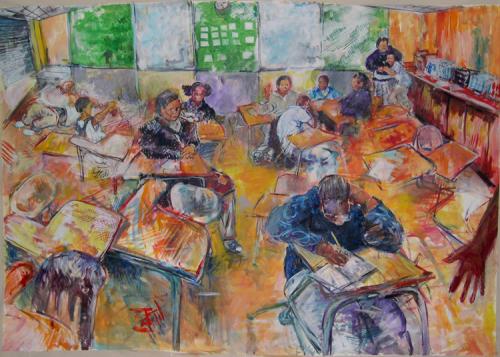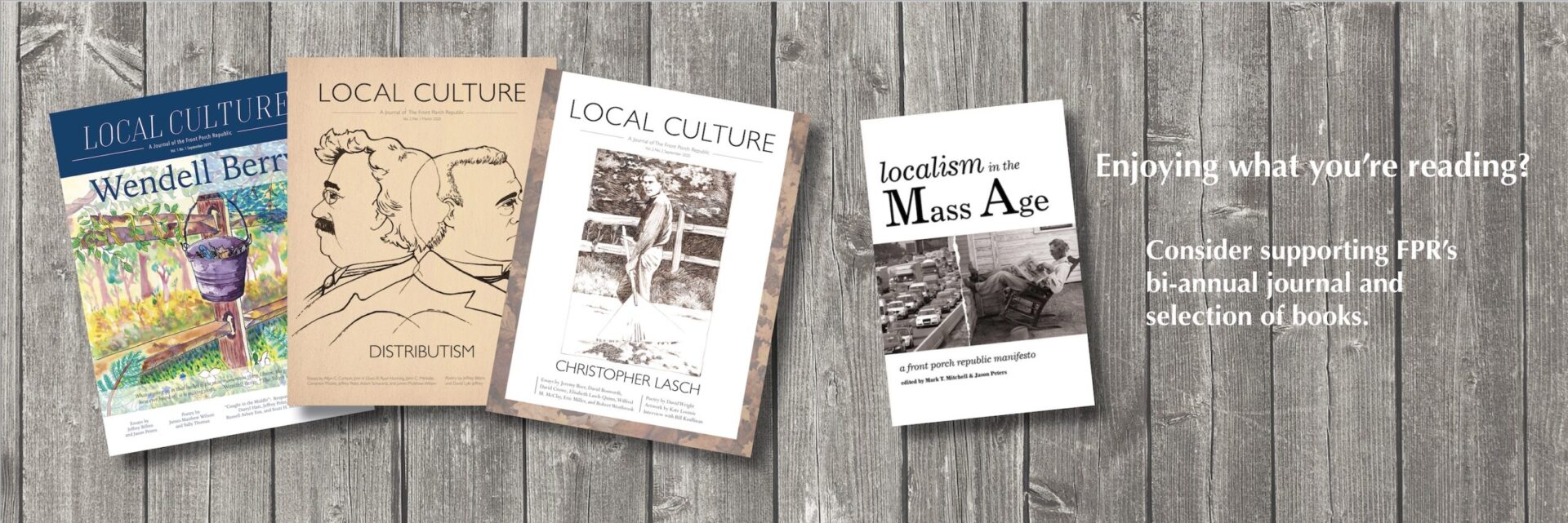Kankakee, IL.
When Nightlife Hample grabbed Tol Proudfoot’s shotgun and headed into the woods, Tol’s day took an unexpected turn. I often see this pattern in my own special education classroom: emotional frailty quickly upends my plans and escalates into crisis. In these moments, my mind is consumed with the priorities of quickly neutralizing the threat and keeping everyone safe. But Wendell Berry’s short story, “Watch with Me” illustrates a deeper set of priorities. As Tol follows the shotgun-wielding Nightlife into the woods, readers watch a crisis response that aims for the wholeness of Nightlife and of the entire Port William community.
My own classroom is full of emotional frailty. Mostly, my 9-, 10-, and 11-year-old students are like any other group of kids: energetic, funny, eager to learn, eager to please. But occasional outpourings of emotional distress have given me a front row seat to some monumental meltdowns. Whirlwinds of tiny flying fists and feet, desks and chairs sliding across the floor, children whisked off in ambulances to start days- or weeks-long stints with pediatric mental health specialists. National trends indicate that heartbreaking scenes like these are increasingly common.
From my vantage as a teacher, I have watched the ways institutions isolate kids in extreme distress. When a child’s behavior is out of adults’ control, the child is often removed from their homes for several days for individual therapy and to regulate medications. These interventions are not without value; they have “efficacy.” But the isolation of an individual in crisis has a cost to the individual, their families, and their communities.
This cost is powerfully felt by contrasting it against Tol Proudfoot’s response to Nightlife Hample in “Watch with Me.” The story can serve as a model for those of us who find ourselves helping students, family members, patients, or neighbors in mental crisis. In the paragraphs below, I will highlight three features of this story’s model that stand out starkly against our modern approaches to crisis response. I will then describe ways that the story speaks to me and others who are “in the trenches” with people in extreme distress. Before we get there, some stage-setting is in order.
The story takes place in the fall of 1916. Our principal character, Tol, is revered in the Port William neighborhood: known for his large size, his ill-fitting clothing, his wrestling prowess, and his deep devotion to his wife, Miss Minnie. If Tol is revered, Nightlife is merely tolerated. Nightlife comes from a family that is known for their combination of handiness and drunkenness, and “for the fact that from one generation to another not a one of them had worked quite right” (p. 82).
Among the Hamples, Nightlife struggles most intensely. He bears his nickname because he couldn’t “tell daylight from dark, and therefore was liable to conduct his nightlife in the daytime” (p. 82), and because darkness and isolation sometime descended upon him: “His mind . . . had a leak in it somewhere, some little hole through which now and again would pour the whole darkness of the darkest night” (p. 88).
On the morning the story begins, Nightlife approaches Tol’s tool shed, upset because the local and visiting preachers have declined Nightlife’s request to share a sermon at an upcoming church service. Nightlife seems to be looking to Tol for consolation, but he finds that Tol is already talking with his nephew (Sam Hanks), which agitates Nightlife further.
Ruminating on this disappointment, Nightlife meanders into Tol’s shed where he happens upon an old shotgun propped against a wall. He picks up the gun and examines it, then rests it on his shoulder and starts to walk away from the shed toward the woods. Tol quickly hollers over to Nightlife, directing him to put down the gun. At this, Nightlife pauses for a moment to consider, then answers, “Why, a damned fellow just as well shoot hisself, I reckon” (p. 84).
Hearing this, Tol follows Nightlife into the woods. Tol doesn’t anticipate what the pursuit will mean for him. But he comes to spend the entire day, the next evening, and the following morning trailing Nightlife through the woods, making sure his neighbor doesn’t shoot himself or anyone else. Along the way, several others join the pursuit, with varying levels of willingness. A full day later, when Nightlife comes back to himself and lays down the old shotgun, the company that has been following Nightlife finally gets to hear the sermon he had wanted to deliver. And what a sermon. In the words of the group’s wisecrack Walter Cotman, “The son-of-bitch could preach!” (p. 122).
Embeddedness
A fundamental feature of the story is that Nightlife Hample is embedded in a community. Tol follows Nightlife from a place of membership, bringing along several of Port William’s other community members on the way. Our narrator, Andy Catlett, interrupts the plot to reflect on the Hample family: how they initially came to the area, their reputation as can-do fixers and irresponsible drinkers, and how Nightlife fit within their clan. Some characters (Sam Hanks, Burley Coulter, and Uncle Otha and Aunt Cordie Dagget) appear again in Berry’s better known Jayber Crow, where they each play a part in helping Jayber find his own way home.
The response to Nightlife was a community effort made by a community that already included Nightlife. The concern for Nightlife happened within “a moving room that at once divided and held them together” (p. 92), in which the whole membership was concerned with each member, and with the membership itself. A tragedy that befell Nightlife would have caused a collective breakage. When Nightlife becomes restored to himself in the end, the whole membership is spared from damage.
Holy mystery
When Tol begins to follow Nightlife into the woods, he leaves the workspace of his tool shed and farm and enters the woods. Berry describes this entrance as if Tol is passing through a portal from a familiar place of responsibility into a different—but also familiar—place of mystery.
In spite of the several small troubles of that morning, [Tol] had been in a world that was more or less the world he thought it was, and where at least some things happened more or less as he intended. But now he was walking down through the wet grass of his cow pasture toward the edge of his woods, a place as familiar to him as the palm of his own hand, in a world and a day in which he intended nothing and foresaw nothing. (p. 85)
Tol’s responsibility to Nightlife draws him away from his work-a-day world of plans and intentions and into the world of patience and mystery. Yet Tol’s familiarity with walks in the woods and with the frame of mind that lies outside of the manmade order makes his steadfast act of friendship possible. When he needed to enter the unknown that lay outside this manmade order, Tol was not lost.
Wholeness over expediency
By early afternoon there are six different neighbors following Nightlife, and the group has not had any food, water, or rest. Tol begins to ruminate on his own suffering and on the futility of the mission:
He said to himself, “I reckon it would be better not to have got involved.” But he knew even so that helpless or not, hopeless or not, he would go along with Nightlife until whatever happened that would allow him to cease to go along had happened. . . He thought, “I reckon I am involved.” (p. 101)
Here, Tol is not making a heroic or altruistic decision. He is following the logic of his situation. Given Nightlife’s irrevocable membership in the Port William community and given Tol’s familiarity with the mysterious unknown, it follows that Tol must be involved in Nightlife’s mysterious crisis. He must follow it, watch it as closely as he can, as long he can. Through this longsuffering that Tol and his friends take upon themselves, the community absorbs some of Nightlife’s suffering as its own. Nightlife’s journey through a dark day and night becomes everyone’s.
This longsuffering, patient approach of Tol and company pave the way for Nightlife to be restored to wholeness. In the end, the threat is not merely neutralized; Nightlife returns fully—from extreme self-absorption and isolation—to the membership.
Implications
Despite being set in a time and place so different from our own, “Watch with Me” offers important critiques and wisdom for present-day crisis response.
1. Crisis responses and treatment plans need to conceive of the individual’s community as part of the healing process. When Tol and company follow Nightlife, they follow a friend. They are not following a random suspicious individual who is disrupting their peace, or a student or client who is on their professional caseload. Nightlife belonged to them all, and this belonging was a strength that helped him to restoration. The story speaks to me when I have a student in distress. It asks me to consider: “Who are the people most committed to this kid, and how can I get them involved?” and “How can I use my own bonds with this kid to help them out of the state they’re in?”
2. Patterns of familiarity with holy mystery prepare us for crisis. To be agents in the world involves an orderly sort of thinking: plans, objectives, and intentional thoughts. Yet the world is also full of realities that are beyond our control. Tol made a habit of leaving the farm that required his care and attention to enter the wooded world that was outside of his control. We are wise to regularly put down our work and open ourselves to the mystery around us. This discipline creates in us an acceptance and openness to troubled people we encounter. When I have a student who’s in distress, this story whispers to me: “Welcome back to the unknown,” and “Watch! What is here to learn that has nothing to do with my own intentions for the day?”
3. A peaceful crisis response paves the way for restoration and wholeness. It is easy to imagine that if this story were transported to a modern American context, a host of obstacles to restoration and wholeness would arise. Police would be called and a rush of flashing lights, wailing sirens, and drawn weapons would follow. The hubbub of emergency response would add to the distress and fragmentation Nightlife was experiencing. He likely would be detained and then taken somewhere in isolation. This ruckus would further fragment Nightlife and preclude his peaceful restoration. When a person is in distress, the story reminds me to consider: “How can I keep the sensory stimulus of crisis response low?” and “How can I patiently value restoration of the individual over efficient neutralization of the threat?”
Effort and Grace
Tol’s wife, Miss Minnie, was a schoolteacher to Nightlife, and she was one of the members who passed the story along to its eventual narrator, Andy Catlett. It was Miss Minnie’s account that Andy found most authoritative, for, from her vantage as a teacher, “she knew pretty exactly by what precarious interplay of effort and grace the neighborhood had lived” (p. 123).
Effort and grace. The exact interplay of these ingredients found in the Port Williams membership of 1916 is not available to us now. Yet fostering and honoring the embeddedness of our neighbors, attending to the mystery that stands outside our control, and patiently suffering in solidarity are possibilities before us still. These remain as models to help us see and care for the hurting around us and the memberships to which they belong.
This essay is dedicated to the memory of Erik Young.
Image Via: Flickr













“Welcome back to the unknown,” and “Watch! What is here to learn that has nothing to do with my own intentions for the day?”
I copied this in my commonplace book. I can think of several times this week alone it would have come in handy.
Brian’s reflection beautifully captures the essence of Wendell Berry’s work, highlighting the quiet strength of community and the wisdoms that is drawn from the characters. Brian’s ability to draw a line between Berry’s pastoral themes and the environment of a modern-day classroom is both insightful and heartwarming. The connections he makes remind us that the values of patience, attentiveness, and care—so central to Berry—are important for teachers to consider for their own classroom. .
This piece doesn’t just comment on literature; it encourages us to slow down and appreciate the small moments that build connection, whether in a rural town or a classroom full of students. Brian’s writing carries a calm tone that mirrors the message he’s conveying, making the article not only meaningful but also a genuinely pleasant read.